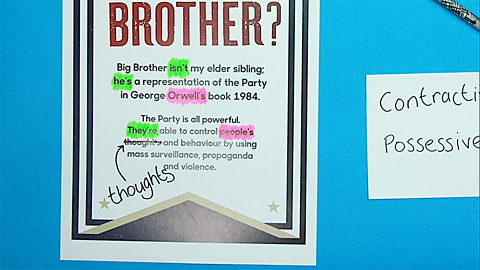Introduction to punctuating quotations in an essay
A quotation is a phrase‚ÄØtaken directly from a text or speech.
- In literature essays, the points you make about a text should be supported by short quotations from the text
- There are different ways of using a quotation within the structure of an essay sentence or paragraph
- It’s important to  carefully punctuateInsert punctuation marks into a text.  your quotations, so that the meaning is clear
In a quotationA group of words taken from a text or speech and repeated by someone other than the original author or speaker. it’s important to make sure you use the exact words from the original text. In most literature essays, it’s better to use shorter quotations in a precise way rather than write out very long quotations. You can use single inverted commas ‘ ’ or double quotation marks “ ” to punctuate the quotation. Just make sure you stick to the same punctuation mark and don’t swap between the two.
These punctuation marks should contain the words taken from the text:
In ‚ÄØA Christmas Carol‚ÄØby Charles Dickens the character of Scrooge is described as being "Hard and sharp as flint".
In the example above, "Hard and sharp as flint" is taken directly from the text.
Remember to close the punctuation marks at the end of the quotation. Only use a capital letter in a quotation if one appears in the original text.
Video about punctuating quotations
Learn how to use and punctuate quotations in essays
Punctuation inside quotations
Punctuation that appears in the original text should be used in the quotation:
The character of Scrooge is described as "self-contained, and solitary as an oyster."
In this example, the comma and full stop in the phrase "self-contained, and solitary as an oyster." appear in the original text and therefore need to be included with the quotation.
Sometimes a full stop is used outside of the quotation marks, this is because the full stop belongs to the whole sentence, not the original quotation:
In A Christmas Carol by Charles Dickens the character of Scrooge is described as being "Hard and sharp as flint".
Find the quotation

Correctly punctuate the quotation in this sentence.
In an extract from A Christmas Carol, Scrooge is described using the metaphor a tight-fisted hand at the grind-stone which tells the reader that he is a tough boss to work for and he probably doesn’t treat his employees fairly.
In an extract from A Christmas Carol, Scrooge is described using the metaphor "a tight-fisted hand at the grind-stone," which tells the reader that he is a tough boss to work for and he probably doesn’t treat his employees fairly.
Using quotations in an essay
There are different ways to use a quotation in an essay. For example, you could embed a quotationBlend a quotation into your own sentence. into your sentence or separate the quotation with a colonA punctuation mark (:) used to introduce a list, a quotation or an explanation. after your point.
Embedding quotations
An effective way to use quotations is to embed them into your argument. Embedding is when the quotation becomes‚ÄØpart of your own sentence:
The reader gains a negative impression of Scrooge, who is described as a "tight-fisted" man and an "old sinner".
This method allows you to use quotations in a precise way and select evidence carefully.
Pick the best phrase
Using quotations at the end of a point
Another common method is to use a quotation at the end of a point. A colon must be used before the quotation.
The reader gains a negative impression of Scrooge: "But he was a tight-fisted hand at the grindstone, Scrooge! a squeezing, wrenching, grasping, scraping, clutching, covetous, old sinner!"
Place the colons
How to separate a longer quotation
If a much longer quotation is being used, it is appropriate to separate it from the main essay by‚ÄØleaving a line‚ÄØand‚ÄØindenting the text. Indenting means leaving a gap after the left-hand margin. It is not necessary to use quotation marks if the text is separate from the main essay. You could introduce the quotation like this:
In the beginning of the novel Dickens establishes the details of Scrooge’s character for his reader in a collection of negative verbs and powerful similes.
Below the introductory sentence you would leave a line and then indentTo start writing further from the margin that the main part of a text. the quotation.
See it in action
This is how the text currently looks:
In the beginning of the novel Dickens establishes the details of Scrooge’s character for his reader by using a collection of negative verbs and powerful similes.But he was a tight-fisted hand at the grind- stone, Scrooge! a squeezing, wrenching, grasping, scraping, clutching, covetous, old sinner! Hard and sharp as flint, from which no steel had ever struck out generous fire; secret, and self-contained, and solitary as an oyster.
This is how a longer quotation should look:
In the beginning of the novel Dickens establishes the details of Scrooge’s character for his reader by using a collection of negative verbs and powerful similes.
But he was a tight-fisted hand at the grind- stone, Scrooge! a squeezing, wrenching, grasping, scraping, clutching, covetous, old sinner! Hard and sharp as flint, from which no steel had ever struck out generous fire; secret, and self-contained, and solitary as an oyster.
- A line has been missed
- The quote is indented
- There are no quotation marks
Key points
Remember
Using quotations accurately makes your essay more convincing and shows that you are able to use evidence to support your points. You can show that you understand which parts of the text are relevant to the point you are making if you are able to select the key parts.
Test your knowledge
More on Punctuation
Find out more by working through a topic
- count4 of 6

- count5 of 6

- count6 of 6

- count1 of 6
